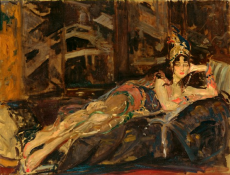
Another technique employed by Opera that has since pervaded into the world of cinema, is that of the leitmotif. The leitmotif ‘developed out of the so called “reminiscence motif”… whereby a motif (even just a chord or timbre), complete melody, or even an entire number would be recalled for associative purposes.’ Leitmotifs are typically melodies or ‘themes’ that are repeated throughout an opera (for example) in the context of a certain thing, e.g the same melody always being played whenever a certain character is on stage. This greatly aids the concept of continuity within an opera; a recurring theme in a minor key for example, can continuously serve to remind the audience of a character’s negative intentions. Sometimes a leitmotif will remain exactly the same for the entirety of an opera, but others, it will be subtly altered so it is still recognisable and still brings to mind the same associations, but the rhythm may be altered, or the key or the tempo for example; ‘Thematic relationships need to strike a balance to be effective…developed themes must be altered enough that they are distinct from the original. On the other hand, the themes must share a unifying idea that is central to the themes’ identities.’ This works particularly well in terms of expressing the individual. If a character has a leitmotif, but the motif is then performed at a slower tempo or with a rallantando for example, it may signify to the audience that something sad is happening, or if the rhythm of the leitmotif is altered, it could be a reflection of altered circumstances for the character in question, either good or bad.
A notable example of a successful leitmotif, would be Rimsky-Korsakov’s ‘Scheherazade.’ The two central and polarized characters are both given an accompanying leitmotif that perfectly demonstrates their character, both rhythmically and orchestrally. The most obvious difference, is the cleff; the Sultan’s theme is in the bass, whereas Scheherezade’s is a lighter theme in the treble cleff. The Sultan’s motif uses a whole tone scale which steadily descends, with a relatively slow tempo and sustained notes. The longer notes suggest the dominance of the Sultan as they linger without any sense of urgency. Scheherezade’s theme by contrast, is mostly in triplets, in a drastically higher pitch, reflecting the fragility and also mystery of the character; the motif is quick, and as such, it is harder to discern much about her character. Violin and harp accompany Scheherezade, typically feminine instruments, whereas deep woodwinds convey the power of the Sultan.
A contemporary incorporation of the leitmotif, clearly demonstrating its diffusion into the world of film, is the Pixar film, ‘Inside Out.’ The film depicts the emotions within the protagonist’s head, such as Anger and Joy. The two focal emotions are Sadness and Joy, and as such, Pixar cleverly provides each with their own leitmotif. It is a very subtle technique, but arguably a very intelligent one, that ensures that younger audiences with be able to more fully grasp the emotions portrayed, even on a subconscious level. Joy is usually accompanied by a sparkling, light little melody performed by flute, subsisting of only a few notes, but backed by an undeniably soothing strings section, all in a major key and middle pitch, so there can only connotations of pure contentment and happiness. However, with the arrival of Sadness, we hear a notable change. A deep bassoon lumbers in, with an awkward cascading melody, which threatens to sound so miserable and low that it is almost dissonant, thereby unfailing flooding the audience with a feeling of despair. Thus, opera has once again defied its stereotype of being accessible to only the elite, as now, parts of it are now even readily within the reach of children.
Image1: https://twitter.com/lovalh/status/461893789695475712

0 Comment:
Be the first one to comment on this article.